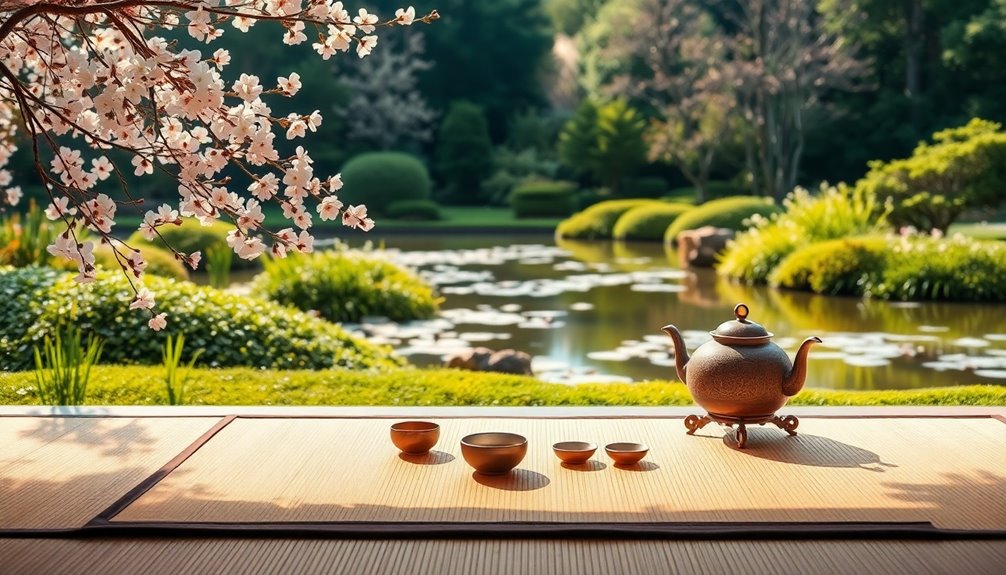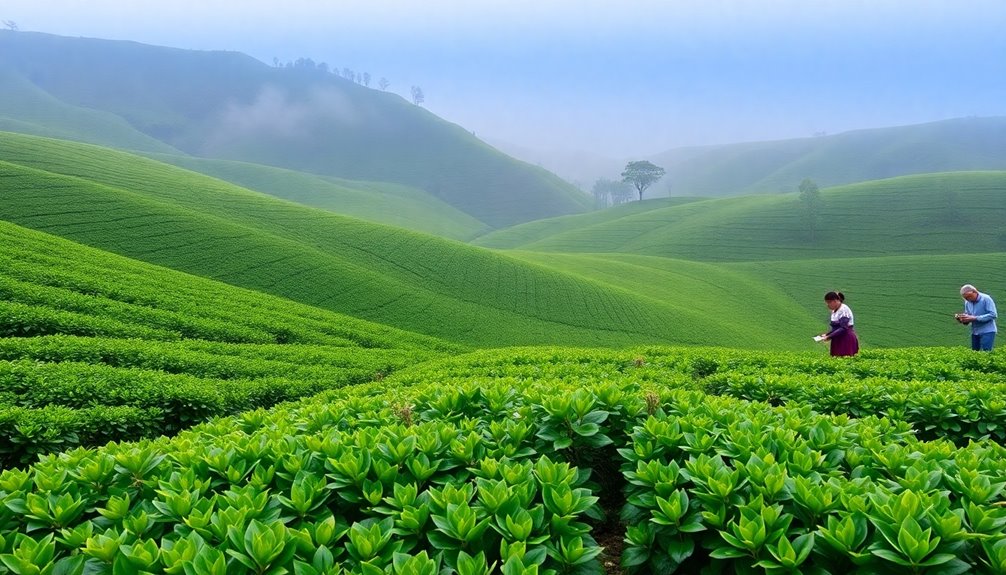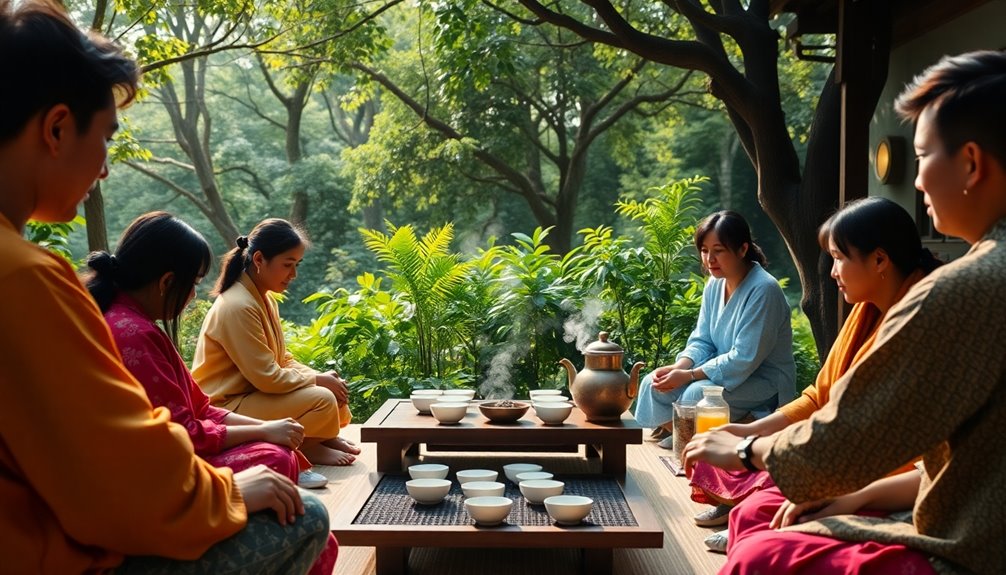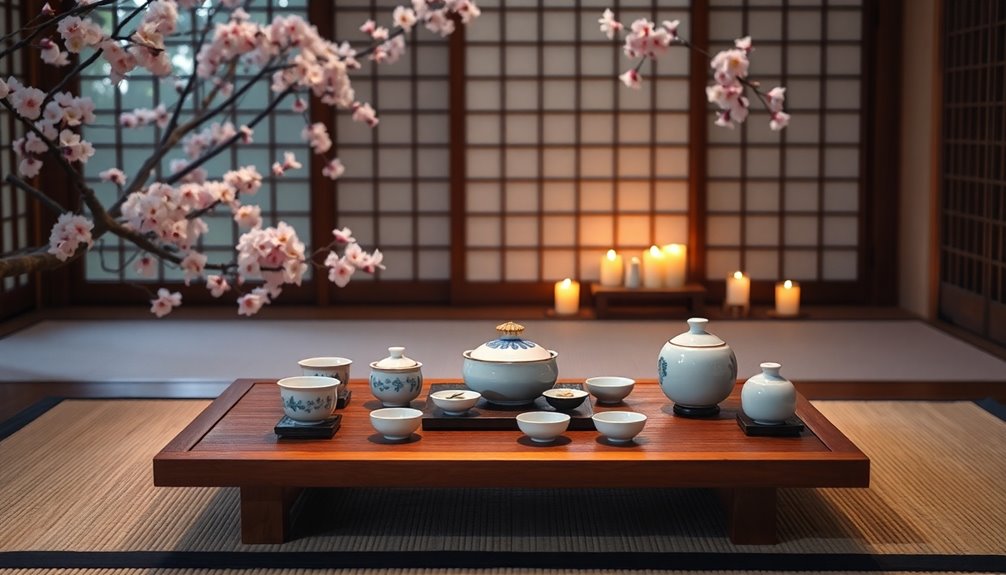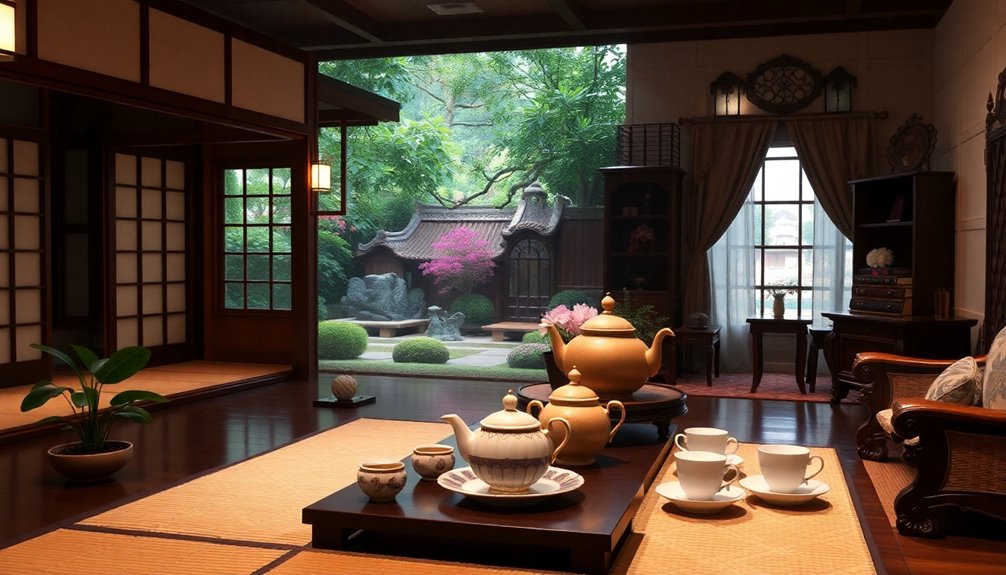Tea ceremonies celebrate connection and tradition, making them the perfect way to bring people together. Each culture has its unique customs, like Japan's chanoyu, which emphasizes respect and simplicity, or China's Gongfu, focusing on exploring flavors. In India, masala chai reflects personal and regional styles, while Moroccan mint tea symbolizes hospitality. Each item, from the chawan bowl to the Yixing teapot, has special meaning, too. It's important to appreciate these practices while respecting their origins. Whether you're hosting a ceremony or enjoying tea with friends, embracing these rituals can enrich your experiences. Keep exploring to uncover more about tea traditions!
Key Takeaways
- Tea ceremonies cultivate friendships and peace, serving as a medium for creating lasting memories and cultural exchange.
- Japanese chanoyu emphasizes harmony and tranquility, while Chinese Gongfu focuses on flavor exploration through multiple infusions.
- Indian masala chai and Moroccan mint tea highlight regional variations and community hospitality through their unique preparation methods.
- Symbolic utensils like the chawan and chasen represent connection, dedication, and precision in the tea preparation and serving process.
- Engaging with tea traditions requires understanding their historical context, promoting appreciation rather than cultural appropriation.
Introduction
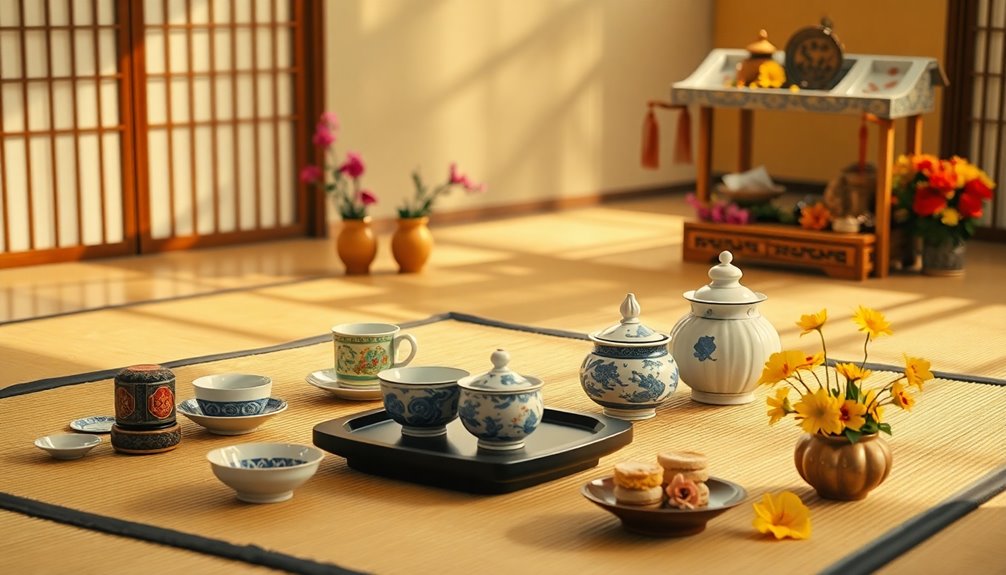
Tea ceremonies offer a fascinating glimpse into the cultural fabric of societies around the globe, showcasing how a simple beverage can embody deep traditions and philosophies. Each ceremony, whether it's the Chinese Tea Ceremony or the Japanese tea ceremonies, reflects unique customs and values.
In Japan, the ceremony, known as chanoyu, revolves around the preparation and serving of matcha, emphasizing harmony and respect. On the other hand, the Chinese Gongfu tea ceremony focuses on the art form of brewing tea with precision, using small teapots and multiple infusions to enhance flavors.
As you explore these ceremonies, you'll discover how they foster cultural exchange and create warm social gatherings. For example, Indian chai, a spiced tea, highlights the country's rich culinary heritage, often prepared with a blend of black tea, spices, and milk.
Similarly, Moroccan mint tea is brewed with green tea and fresh mint, showcasing hospitality traditions where it's served ceremonially, symbolizing warmth and community.
These tea ceremonies are more than just drinks; they're an experience, inviting you to step into a world of tradition, artistry, and connection. So, grab a cup of tea and enjoy the journey!
Cultural Significance of Tea

Each of these traditions emphasizes the art of tea and how it fosters friendships, promotes peace, and creates lasting memories.
Rituals Vary by Region
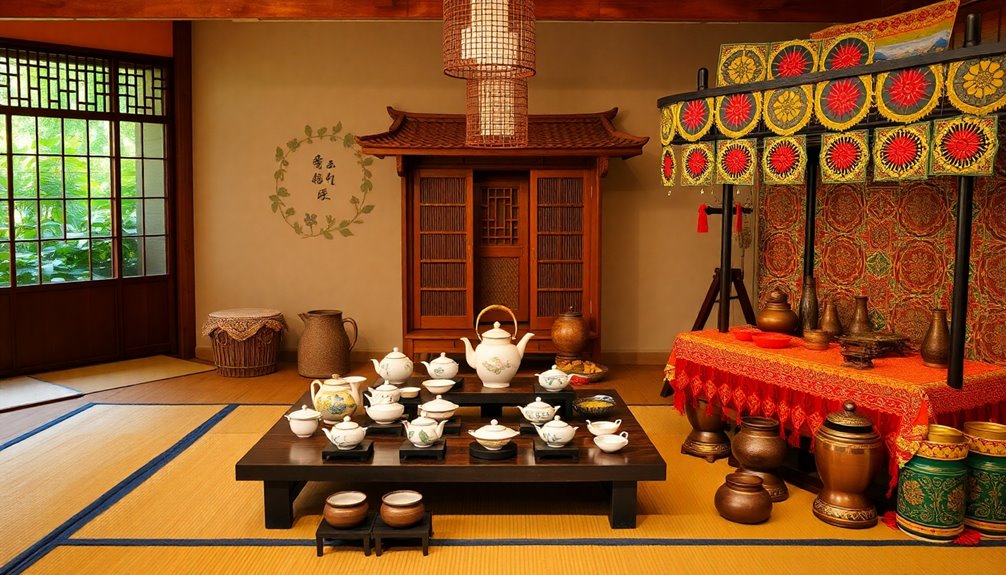
Cultural diversity enriches the rituals surrounding tea around the globe, with each region offering its unique practices that reflect local values and traditions.
In Japan, the tea ceremony known as chanoyu focuses on harmony, respect, purity, and tranquility, with matcha being prepared with great care. You might find yourself captivated by the beauty of this ritual.
In contrast, the Chinese Gongfu tea ceremony invites you to engage in multiple infusions of high-quality tea. Using small teapots and Gaiwan, you can meditate and enjoy the evolving flavors and aromas of the tea.
Traveling to India, masala chai is a beloved daily tradition, blending black tea with spices, showcasing regional variations and personal touches that embody local culture.
If you visit Morocco, you'll experience mint tea, an art form in itself, symbolizing hospitality. It features green tea, fresh mint leaves, and sugar, served with care to create a sense of community.
Lastly, the Korean tea ceremony, known as Darye, emphasizes simplicity and nature. You'll brew green tea in a ddukbaegi, often enjoying it with traditional sweets, creating a unique connection to the earth.
Symbolism of Tea Utensils
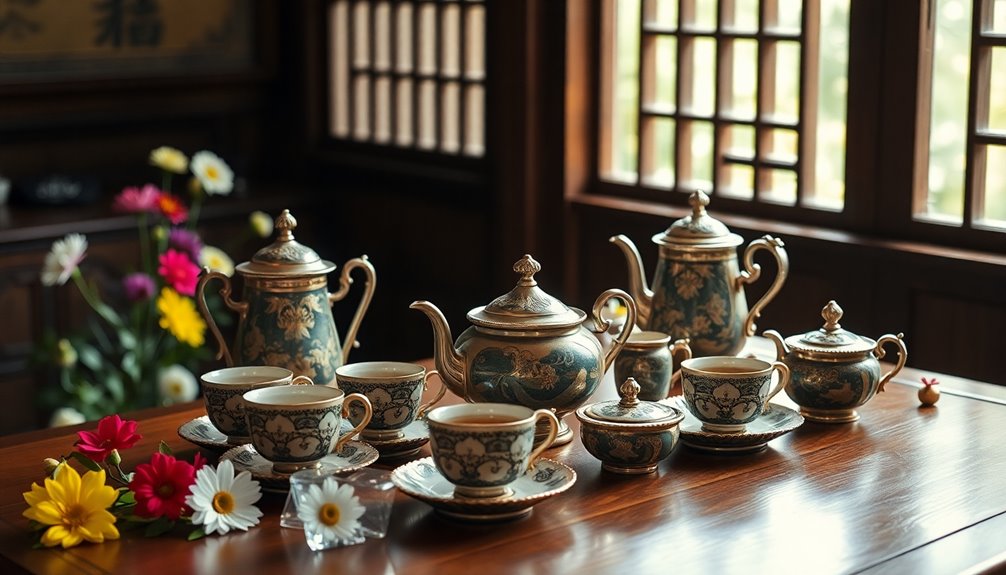
Understanding the rituals surrounding tea naturally leads to an appreciation of the utensils used in these ceremonies. Each tool holds deep symbolism that enhances your tea experience.
In the Japanese tea ceremony, the chawan (tea bowl) represents the heart of the gathering. It not only holds the tea but also connects the host and guests.
The chasen (bamboo whisk) is more than a mixing tool for matcha; it symbolizes harmony and the tea master's dedication to achieving a perfect blend.
The chashaku (bamboo tea scoop) signifies simplicity and precision, highlighting the importance of measuring the right amount of tea for the best flavor.
When you explore Gongfu tea ceremonies, the Yixing clay teapot stands out. Its porous nature absorbs flavors over time, enhancing the tea's complexity—truly a relationship between the tea and the pot.
Finally, in the Japanese tea ceremony, the natsume or chaire (containers for powdered tea) emphasizes the care taken in storing and preserving quality tea.
These tea utensils not only serve practical purposes but also enrich the overall experience of the ceremony, making each sip a celebration of tradition and craftsmanship.
Cultural Appropriation Debates
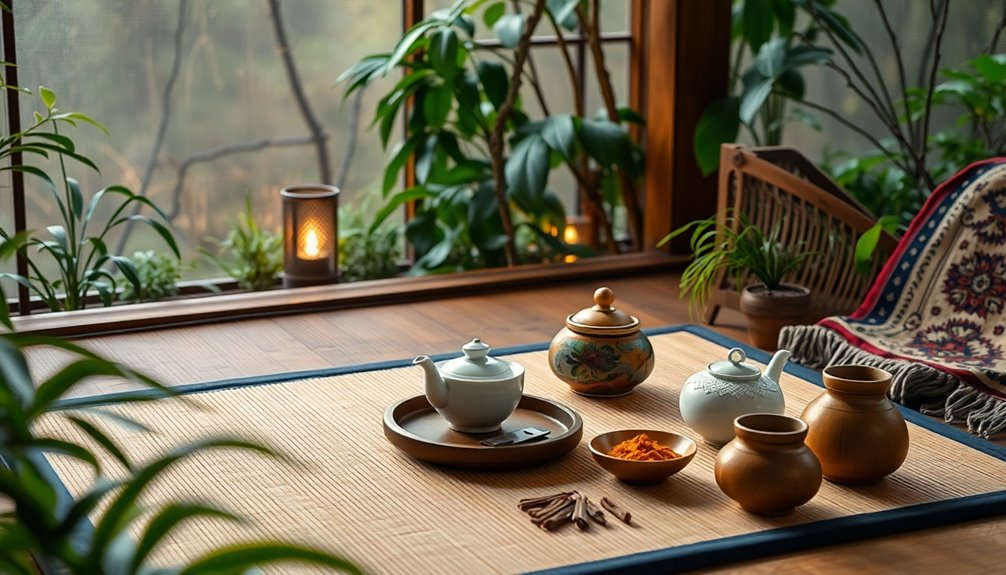
To truly celebrate tea culture, focus on understanding the traditions and showing respect for their origins.
This way, you can enjoy and share tea without crossing the line into cultural appropriation.
Practical Applications
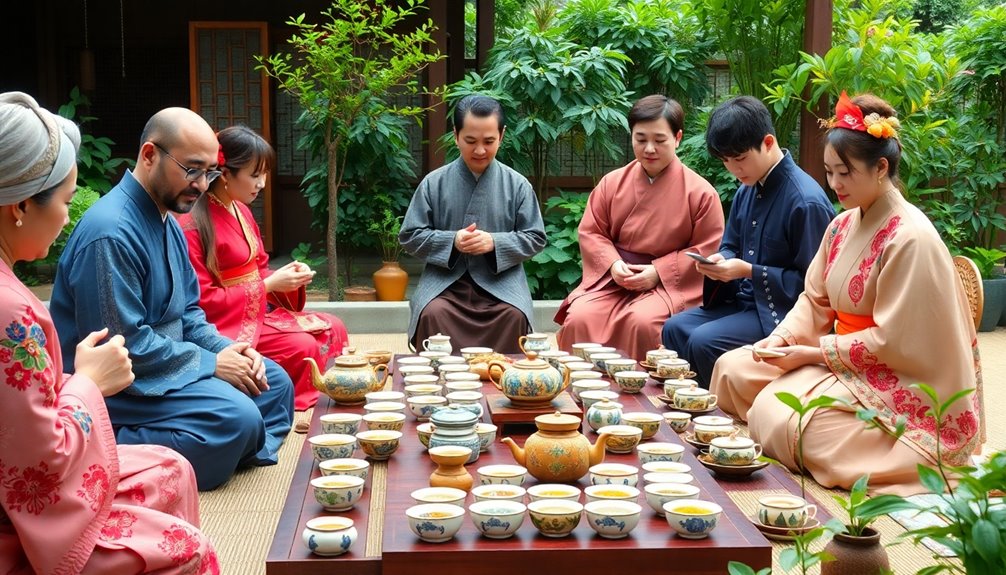
Tea ceremonies around the world offer practical applications that can enhance your daily routine and social gatherings. By engaging in these ceremonies, you can bring mindfulness and harmony into your life.
For example, when you practice the Japanese tea ceremony, you focus on preparing and drinking tea with great respect. This experience teaches you to appreciate simplicity and tranquility.
In Chinese Gongfu tea ceremonies, you use small teapots for multiple infusions, paying attention to water quality and temperature. This attention to detail improves the flavor and aroma of the tea, creating a meditative atmosphere.
If you're hosting guests, consider a Moroccan mint tea ceremony. You can showcase your hospitality by pouring tea dramatically from a height, which aerates the tea and creates a sense of community.
Don't forget about the British afternoon tea! Offering a selection of sandwiches, scones, and pastries, alongside various teas, creates an elegant social event.
Frequently Asked Questions
Which Country Is Famous for Tea Ceremony?
When you think of tea ceremonies, Japan's "chanoyu" often comes to mind, but don't overlook China's Gongfu, India's chai, Korea's Darye, or Morocco's mint tea rituals, each offering unique cultural experiences and traditions.
What Is a Sacred Tea Ceremony?
A sacred tea ceremony is a ritual that emphasizes mindfulness, respect, and beauty in tea preparation and serving. It fosters connection among participants, creating a tranquil atmosphere where you can appreciate each moment and flavor fully.
What Is the Art of Tea?
The art of tea involves mindful preparation and enjoyment, creating a sensory experience that fosters connection. It's about appreciating beauty, tradition, and the moment, making each cup a reflection of culture and personal expression.
What Are the 4 Principles of Japanese Tea Ceremony?
In the Japanese tea ceremony, you embrace four principles: harmony (wa), showing respect (kei), ensuring purity (sei), and cultivating tranquility (jaku). These guide your interactions, creating a serene and meaningful tea experience for everyone involved.
Conclusion
In conclusion, tea ceremonies are more than just sipping a warm drink; they're a celebration of culture and tradition all over the world. Each ceremony has unique rituals, symbols, and meanings that connect people, making it a special experience. As you explore different tea traditions, remember to respect their origins and significance. So, whether you're hosting a tea party or enjoying a quiet moment with a cup, embrace the joy and connection that tea brings to our lives!

